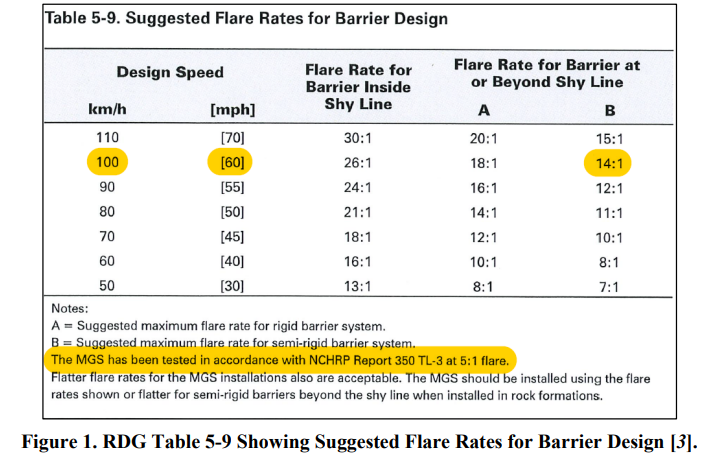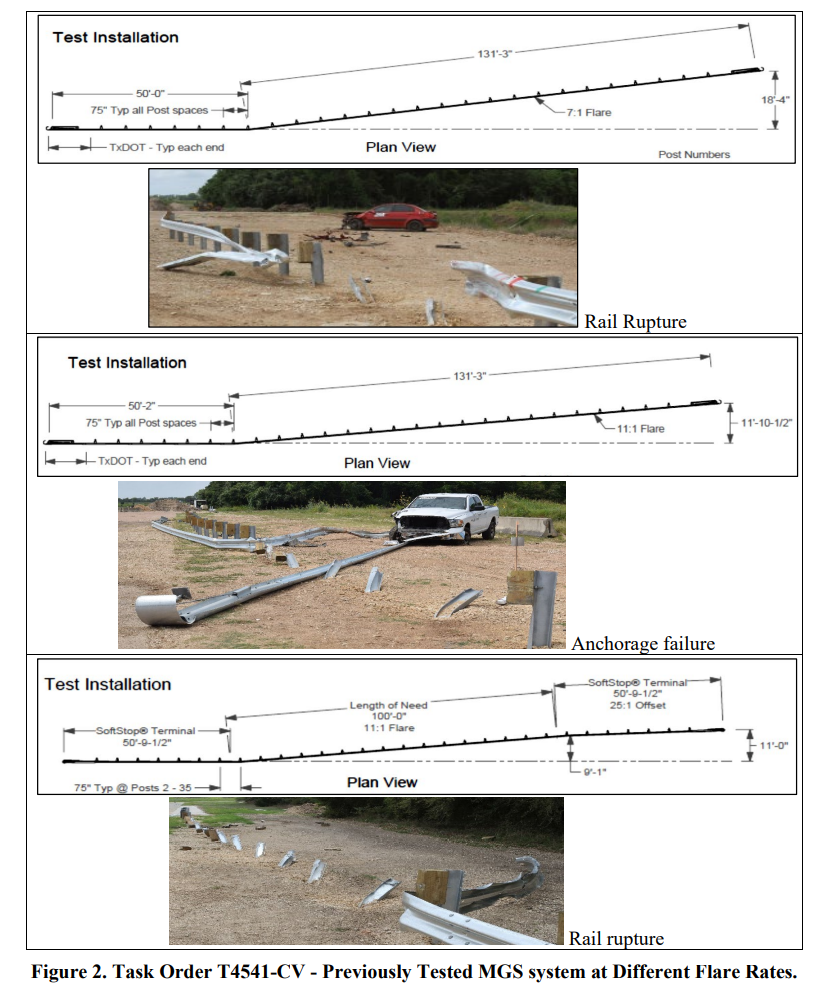Phase 1 (609971) Project Details
| TTI Research Supervisor: Sun Hee Park, Ph.D. Associate Research Scientist Texas A&M Transportation Institute TAMU 3135 College Station, Texas 77843-3135 (979) 317-2688 [email protected] | Pooled Fund Technical Representative:Tim MoeckelRoadside Safety Engineer WSDOT Development Division Washington State Department of Transportation P.O. Box 47329 Olympia, WA 98504-7246 (360) 704-6377 [email protected] |
This proposed research is to continue an investigation following the recently completed pooled fund task order T4541-CV “Testing and Evaluation of the MGS System with Critical Flare at MASH Test Level 3 Conditions” [1]. The purpose of the project was to investigate the critical flare for the Midwest Guardrail System (MGS) under American Association of Highway and Transportation Officials (AASHTO) Manual for Assessing Safety Hardware (MASH) [2] Test Level 3 (TL-3) testing and evaluation criteria. Critical flare rates for the MGS system were only investigated according to TL-3 criteria per previous NCHRP Report 350 standard requirements. Currently, AASHTO Roadside Design Guide (RDG) [3] Table 5-9 lists suggested flare rates for barrier design based on NCHRP Report 350 test results as shown below. In task order T4541-CV [1], the research team conducted engineering analysis and computer simulation along with crash tests on the MGS system using three different configurations. Based on the RDG, the initially tested system had a 6 ft–3 inches post spacing with the rail splices off the post and standard steel post length of 6 ft at a 7:1 flare rate. The system was tested under the MASH Test 3-10 condition and the test failed due to the rail rupture. The second crash test was MASH Test 3-11 conducted on the MGS system at an 11:1 flare rate. The test failed due to anchorage failure. The last test was nearly identical to the second test and was conducted on the MGS system at the same 11:1 flare rate but used a proprietary MASH end terminal rather than a generic anchor. Figure 2 shows the tested system drawings and test installation after impact and the reason for failure.
In task order T4541-CV [1], the research team conducted engineering analysis and computer simulation along with crash tests on the MGS system using three different configurations. Based on the RDG, the initially tested system had a 6 ft–3 inches post spacing with the rail splices off the post and standard steel post length of 6 ft at a 7:1 flare rate. The system was tested under the MASH Test 3-10 condition and the test failed due to the rail rupture. The second crash test was MASH Test 3-11 conducted on the MGS system at an 11:1 flare rate. The test failed due to anchorage failure. The last test was nearly identical to the second test and was conducted on the MGS system at the same 11:1 flare rate but used a proprietary MASH end terminal rather than a generic anchor. Figure 2 shows the tested system drawings and test installation after impact and the reason for failure.
 Since all crash tests conducted under task order T4541-CV [1] failed due to structural inadequacy, the research team used its remaining resources to conduct computer simulations using the data obtained from the three failed crash tests. First, computer simulations were run on an unmodified MGS system with flare rates of 15:1, 18:1, and 21:1. The three simulations indicated likely failure due to excessive lateral deflection/pocketing leading to rail rupture and high levels of ridedown acceleration forces. Next, computer simulations were run on a modified MGS system. The MGS system was modified by utilizing half post spacing, shortened blockouts, and/or rubrail. The simulations indicated that the modified MGS system with a 15:1 flare rate would likely pass MASH crash testing. To continue developing a MASH TL-3 compliant flared MGS, the research team conducted a preliminary poll with pooled fund state agencies. State agencies were requested to select their preferred research option: a) Evaluate the unmodified MGS at a flatter than 21:1 flare rate using computer simulations (and perform crash tests if simulations results show the barrier is likely to pass MASH); or b) Perform crash tests on the modified MGS at a 15:1 flare rate. The majority of the state agencies who responded to the poll preferred to continue investigating the unmodified MGS at a flatter than 21:1 flare rate.
Since all crash tests conducted under task order T4541-CV [1] failed due to structural inadequacy, the research team used its remaining resources to conduct computer simulations using the data obtained from the three failed crash tests. First, computer simulations were run on an unmodified MGS system with flare rates of 15:1, 18:1, and 21:1. The three simulations indicated likely failure due to excessive lateral deflection/pocketing leading to rail rupture and high levels of ridedown acceleration forces. Next, computer simulations were run on a modified MGS system. The MGS system was modified by utilizing half post spacing, shortened blockouts, and/or rubrail. The simulations indicated that the modified MGS system with a 15:1 flare rate would likely pass MASH crash testing. To continue developing a MASH TL-3 compliant flared MGS, the research team conducted a preliminary poll with pooled fund state agencies. State agencies were requested to select their preferred research option: a) Evaluate the unmodified MGS at a flatter than 21:1 flare rate using computer simulations (and perform crash tests if simulations results show the barrier is likely to pass MASH); or b) Perform crash tests on the modified MGS at a 15:1 flare rate. The majority of the state agencies who responded to the poll preferred to continue investigating the unmodified MGS at a flatter than 21:1 flare rate.
The project objective is to evaluate an MGS guardrail system without any design changes at a flare rate shallower than 21:1 for MASH TL-3 using simulation and testing.
The TTI research team will provide a final report that will include a suggested flare rate for a MGS system with a length of need that meets MASH TL-3 specifications.
The work plan for this research includes the following tasks.
Task 1: Finite Element Simulation Analysis:
In Task 1, the research team will calibrate a finite element (FE) model based on data obtained from previously tested MGS systems. The calibration process will involve adjusting model parameters to match the observed behavior of the physical system and ensuring that the model reasonably represents the MGS under realistic conditions. Once the FE model is calibrated, the research team will evaluate the MGS guardrail system at a flatter than 21:1 flare rate. The research team will identify the flare rate that is most likely to meet MASH TL-3 evaluation criteria. Once the flare rate is determined, the research team will determine the critical impact point(s) on the MGS system for MASH tests 3-10 and 3-11.
Task 2: Construction
Task 2 involves a full-scale flared MGS system construction.
Task 3: Full Scale Crash Test
Task 3 involves conducting MASH Tests 3-11 and 3-10 on the flared MGS system. Test 3-11, which is considered the more critical of the two, will be tested first. The research team will analyze the results of this test, and if the MGS system successfully passes this critical test, then the research team will conduct Test 3-10. The research team will conduct both tests in accordance with MASH TL-3 testing conditions.
Task 4: Develop Final Reporting
In Task 4, the research team will prepare a comprehensive final report summarizing the simulation analysis, physical testing results, and recommendations for the use of the flared guardrail system. If the tests performed under Task 3 pass, the research team will also provide the FHWA eligibility letter request form.
REFERENCES
